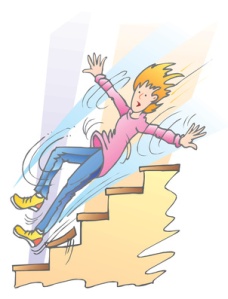 As toddlers we’ve probably all heard “Watch were you’re walking!”. But as adults this can be a very dangerous thing to do and here’s why.
As toddlers we’ve probably all heard “Watch were you’re walking!”. But as adults this can be a very dangerous thing to do and here’s why.
First of all falling as a grownup is extremely weird and a much bigger deal than all those times we landed on our butts and tumbled around as kids. Luckily falling is quite rare as we get older but when it does happen it can be very jarring and disorienting (if we’re sober). Other than feeling embarrassed, we’re just not as good at it anymore as we used to be. The ground is much farther away and we don’t bounce nearly as well now.
It’s bad enough that falling down as grownups is so weird but the older we get, the more emotionally vulnerable a fall can make us feel. There’s something that happens for older adults as we get farther into our second half of life. Falling now becomes high stakes – a threat to our freedom. Locomotion is the single most important thing for the human body and as we age that becomes wildly apparent. Studies show that there is an extremely strong correlation between ambulation (being able to walk around) and the survival rates through illness and old age.
With this all looming. A mere stumble up some stairs or stubbing a foot on an uneven part of the sidewalk, can really throw someone’s psyche for a loop. It’s only natural after something like that to start to become concerned about sureness of footing. The next most natural thing is to start becoming more likely to look down at your feet when you’re walking or stepping, to make sure you don’t have another fall.
Well, watching your feet by looking down at them while you’re moving is guaranteed to cause you to fall again. The habit of watching your feet is disabling your brain. The part of your brain responsible for predicting where your body is in space and where it is going, depends on you to look in the direction of the horizon or at least several steps ahead of your feet while moving. If we look down and watch our feet as we walk, we’re actually turning off the part of the brain that handles this sense of where we are in space – our ability to balance upright against gravity at all moments depends on the system of proprioception inside the brain and spinal cord. You do not want this part of your brain to get lazy! Again the saying: “Use it or lose it!” applies all too well.
If you’re an older adult and you’ve had some falls and you’re worried about your sureness of step, it’s more important than ever for you to NOT watch where you’re walking – at least not directly by looking down at your feet.
Have you had falls that make you feel insecure? Share your story in the comments section.
References:
Journal of Intellectual Disability Research.Volume 32, Issue 3, pages 203–213, June 1988,Prediction of mortality in community and institutional setting, R. K. EYMAN1,*, S. A. BORTHWICK-DUFFY1,T. L. CALL1 andJ. F. WHITE2
http://www.resourcesonbalance.com/clinical_info/BalanceControl.aspx
